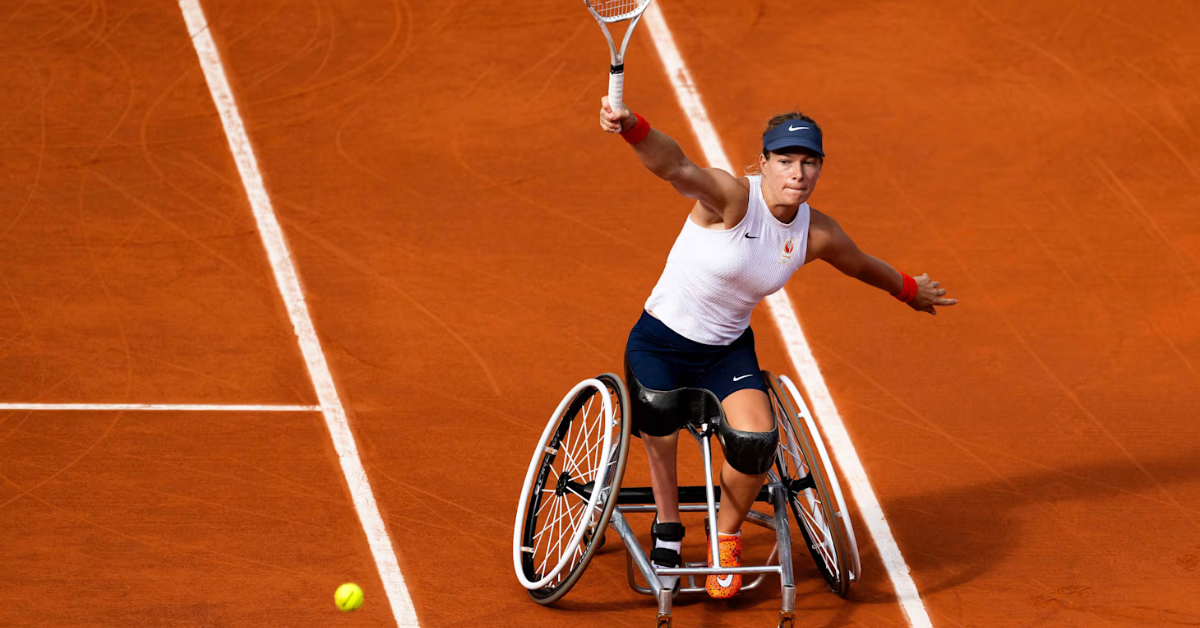Wheelchair tennis is much more than just a game of finesse and technique. At the highest levels, it’s a game of speed, agility, and explosive power. For athletes preparing to compete on the bouncy clay courts of Roland Garros at the Paris 2024 Paralympic Games, mastering these physical attributes is crucial. The unique demands of wheelchair tennis, especially on clay, require athletes to constantly be in motion, and this need for speed is reflected in their innovative and intense training routines.
Creative Drills: Spider, Butterfly, and the ‘Suicide’
The names of the drills used by wheelchair tennis players are as creative as they are demanding: Spider, Butterfly, Fan, and Suicide are just a few. These drills mimic the intricate movements required on the court, such as the butterfly drill, where players make figure-eight movements across the court, simulating the lateral movement needed to switch quickly between forehand and backhand strokes.
The spider drill requires players to navigate small figure eights around cones in the corners of the court, while the fan drill pushes them to move from one corner of the court to the other, always returning to the middle, enhancing their agility. Then there’s the aptly named “suicide” drill, where players dart between the doubles line and various points on the court, testing their stamina and mental toughness.
As Dutch quad player Niels Vink notes, speed drills are essential in preparing for the faster pace of play that the clay courts at Roland Garros demand. “I love it. The faster, the better for me,” Vink said, embracing the unique challenges of clay. His preparation through these speed-focused drills has allowed him to excel, particularly during his quarter-final victory over Canada’s Robert Shaw at the Paralympics.
Training with Fun and Competition
While speed drills can be grueling, many Paralympic athletes incorporate an element of fun and competition into their training to keep it engaging. The Dutch wheelchair tennis team, which includes Paralympic and Grand Slam champions like Diede de Groot, Aniek van Koot, and Sam Schroder, often injects a playful spirit into their routines. For example, they might challenge each other to 20-meter sprints, measuring their progress over time to see who improves the most.
Similarly, the British men’s wheelchair tennis players keep things lively with friendly 100-meter races. Gordon Reid, the Rio 2016 men’s singles champion, proudly recounted his recent victory in a race against his younger teammates. “I won that one. I took the young guys out,” he said with a smile, emphasizing the importance of speed not just on the court but in all aspects of their training.
These competitive games help players stay sharp and enjoy the process of improving their speed and agility. By turning what could be monotonous drills into light-hearted challenges, athletes stay motivated, and their performance on the court reflects their hard work and dedication.
Mastering Movement: From Backhands to Explosive Power
For wheelchair tennis players, speed is not just about how fast they can push themselves across the court; it’s about how efficiently they can move in all directions. Players like Gordon Reid emphasize that mobility is key, especially in a sport where quick turns and rapid changes of direction are essential to success. Reid shared that beyond physical strength, the Dutch team focuses on agility and reaction drills to enhance their ability to move quickly and stay ahead of the ball.
For Argentina’s Gustavo Fernandez, a five-time Grand Slam winner, the emphasis is on explosive power in short bursts. Fernandez trains specifically for those split-second movements that allow him to position himself behind the ball, an essential skill on the tennis court. “We do the explosion exercises, trying to be fast in order to move around the court,” Fernandez explained, highlighting how his training emphasizes short, powerful movements rather than long sprints.
Fernandez’s focus on explosive power is shared by many of the top athletes in the sport, who understand that to be successful in wheelchair tennis, they must be able to react instantly and powerfully to every shot their opponent delivers.
Turning Tennis Training into a Game: The Power of Fun
For many wheelchair tennis athletes, the love for the game stems from the fun they had as children, racing around in their chairs and playing games with friends. World No. 1 Diede de Groot fondly remembers the early days of her training when she would challenge herself to pick up tennis balls as quickly as possible or play wheelchair tag with other kids. These activities may have seemed like simple fun, but they laid the foundation for her remarkable speed and agility on the court today.
De Groot’s experience is echoed by many of her peers, who continue to incorporate fun into their training routines. Turkish player Ahmet Kaplan, for example, often turns his training sessions into games of wheelchair basketball or American football. For Kaplan, these games are not just a way to stay active; they’re also an essential part of his training for wheelchair tennis, helping him stay alert and focused during matches.
The idea of blending fun with training is not new, but it is a powerful tool for keeping athletes motivated and engaged. By finding joy in their workouts, wheelchair tennis players can push themselves harder and achieve greater success on the court.
Strength and Speed: A Balanced Approach
While speed is undoubtedly a critical component of wheelchair tennis, it is only one part of the equation. Athletes like Angelica Bernal of Colombia know that strength is just as important. Bernal spends countless hours in the gym, building the upper body strength necessary to push her wheelchair quickly and hit the ball with power. “We’re working really hard in the gym because you have to move the wheelchair and be quick and hit the balls strong,” Bernal said, emphasizing the importance of conditioning for long, grueling matches that can last several hours.
For Bernal and many of her fellow athletes, the combination of speed and strength is what allows them to “fly on the court,” as she puts it. Whether it’s executing a quick turn or powering through a long rally, wheelchair tennis players rely on a balance of agility, strength, and speed to succeed at the highest levels.
The Paris 2024 Paralympic Games: A Showcase of Skill and Speed
As the Paralympic Games approach, the world will be watching to see how these athletes perform on the biggest stage in wheelchair tennis. The bouncy clay courts of Roland Garros will present unique challenges, but for players like Niels Vink, Gordon Reid, and Diede de Groot, the opportunity to compete on this prestigious stage is a dream come true. Their training has prepared them to handle the speed and intensity of the matches, and their love for the sport will undoubtedly shine through as they take on the best in the world.
For fans of wheelchair tennis, the Paris 2024 Paralympic Games promise to be an exhilarating display of skill, speed, and determination. From the creative drills that these athletes use in their training to the intense competition on the court, wheelchair tennis is a sport that demands the highest levels of athleticism and strategy. As these players push themselves to new limits, they continue to inspire and redefine what is possible in the world of adaptive sports.
Please check for information on the best betting sites in India – https://selectory.org/best-betting-sites/















